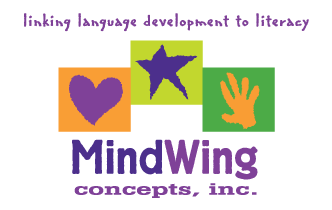Menu
-
- Home
-
About Us
-
The Approach
-
Linking Language & Literacy
-
Professional Learning
-
Learning Resources
-
SHOP
-
Blog
-
- About MindWing
- Our People
- Contact Us
- Your Account
- Login
-
Spain (EUR €)

MindWing Concepts Blog

Two Summer Books (and More) with Feelings!
July 03, 2018
 As a former teacher of 38 years, I know summer is a time for educators to catch some much-needed R&R with family and friends. It is also a time to reflect on the past school year; what we thought went well and what changes we can make in the upcoming school year to improve student learning. I am always on the lookout for new books/materials to add to my lessons and recently came across two books that may interest you...
As a former teacher of 38 years, I know summer is a time for educators to catch some much-needed R&R with family and friends. It is also a time to reflect on the past school year; what we thought went well and what changes we can make in the upcoming school year to improve student learning. I am always on the lookout for new books/materials to add to my lessons and recently came across two books that may interest you...

Tech Tuesday: Contextualizing Narrative and Social Interventions (Minecrafting)
June 26, 2018
 Maybe you’ve heard of Minecraft. In the past several years, this gaming universe has become particularly popular with the elementary set, and also has sparked efforts to incorporate its visually engaging and spatially useful interface into educational contexts. This post was sparked by some questions from a reader of this blog who wrote me to inquire whether I use Minecraft in my work and as a language development context, so I thought I might elaborate on that here. Complicated, right? My philosophy on technology integration in speech and language work has always been that tech is a tool to establish context, engagement, foster interaction and provide visual supports. It’s for this reason that complex, extended activities with technology such as Minecraft are not something I gravitate towards, though they are certainly possible if well planned. After all, we tend to have a limited amount of time for intervention with our students, and every minute is important...
Maybe you’ve heard of Minecraft. In the past several years, this gaming universe has become particularly popular with the elementary set, and also has sparked efforts to incorporate its visually engaging and spatially useful interface into educational contexts. This post was sparked by some questions from a reader of this blog who wrote me to inquire whether I use Minecraft in my work and as a language development context, so I thought I might elaborate on that here. Complicated, right? My philosophy on technology integration in speech and language work has always been that tech is a tool to establish context, engagement, foster interaction and provide visual supports. It’s for this reason that complex, extended activities with technology such as Minecraft are not something I gravitate towards, though they are certainly possible if well planned. After all, we tend to have a limited amount of time for intervention with our students, and every minute is important...

Summer Activities and Learning—2018
June 01, 2018
 “June is bustin’ out all over!” This is a title from a song from the Rogers and Hammerstein Musical, “Carousel.” I played the character of Julie Jordan in this musical back in high school, and this song plays in my mind every June! Also, the month of June has always signified to me—and to most people, probably—the END of school and the BEGINNING of summer. However, for many of us, the start of “summer” means teaching summer school, summer tutoring, doing summer learning programs, conducting language/literacy camps and many other learning activities. Below is a list of blogs/lessons that would be effective and engaging to use with your students in these settings!...
“June is bustin’ out all over!” This is a title from a song from the Rogers and Hammerstein Musical, “Carousel.” I played the character of Julie Jordan in this musical back in high school, and this song plays in my mind every June! Also, the month of June has always signified to me—and to most people, probably—the END of school and the BEGINNING of summer. However, for many of us, the start of “summer” means teaching summer school, summer tutoring, doing summer learning programs, conducting language/literacy camps and many other learning activities. Below is a list of blogs/lessons that would be effective and engaging to use with your students in these settings!...

Tech Tuesday: Problem-Solving Approach Using Story Grammar Marker® Icons
May 29, 2018
 Of late, I’ve unfortunately had a number of students who are needing to deal with getting teased or bullied. This is a tough area to intervene in because it is so sad and frustrating to see a young student being victimized, particularly when their social learning and communicative challenges likely are the reason why. It’s also difficult because we can’t really just provide one way to respond. “Ignore it,” being realistic, oftentimes does not work. Over the past few years, I have worked in these situations around problem-solving approaches, Story Grammar Marker® providing a great tool in the process. Problem-solving can be considered to be a forked format, with SGM®’s icons providing a guide to consider the who, where and when the problem involves, the nature of the problem itself, feelings and internal states/thoughts resulting, and the plan (in the case of teasing, to end it)...
Of late, I’ve unfortunately had a number of students who are needing to deal with getting teased or bullied. This is a tough area to intervene in because it is so sad and frustrating to see a young student being victimized, particularly when their social learning and communicative challenges likely are the reason why. It’s also difficult because we can’t really just provide one way to respond. “Ignore it,” being realistic, oftentimes does not work. Over the past few years, I have worked in these situations around problem-solving approaches, Story Grammar Marker® providing a great tool in the process. Problem-solving can be considered to be a forked format, with SGM®’s icons providing a guide to consider the who, where and when the problem involves, the nature of the problem itself, feelings and internal states/thoughts resulting, and the plan (in the case of teasing, to end it)...

Tech Tuesday: Interpreting Research on Narratives and Autism
April 20, 2018
 In this Autism Awareness and Acceptance Month, we turn our attention more specifically on our students and clients with unique social learning and language characteristics. A recent (2017) study by Westerveld and Roberts, The Oral Narrative Comprehension and Production Abilities of Verbal Preschoolers on the Autism Spectrum, has a number of implications that I would like to interpret in the context of tools available for narrative intervention. The study involved assessment of preschoolers’ narratives (notably an uninvestigated area for preschool students with autism, according to the article) via presentation of a fictional narrative and administration of comprehension questions and a retelling task. A large grouping within the sample did not produce a retelling that could be analyzed, but the 19 that did were assessed for length, semantic diversity, grammatical complexity and accuracy, intelligibility, inclusion of critical events, and narrative stage. The article notes that most of the research on spontaneous language of preschoolers with autism has focused on free play, rather than the ability to pull language together into narratives...
In this Autism Awareness and Acceptance Month, we turn our attention more specifically on our students and clients with unique social learning and language characteristics. A recent (2017) study by Westerveld and Roberts, The Oral Narrative Comprehension and Production Abilities of Verbal Preschoolers on the Autism Spectrum, has a number of implications that I would like to interpret in the context of tools available for narrative intervention. The study involved assessment of preschoolers’ narratives (notably an uninvestigated area for preschool students with autism, according to the article) via presentation of a fictional narrative and administration of comprehension questions and a retelling task. A large grouping within the sample did not produce a retelling that could be analyzed, but the 19 that did were assessed for length, semantic diversity, grammatical complexity and accuracy, intelligibility, inclusion of critical events, and narrative stage. The article notes that most of the research on spontaneous language of preschoolers with autism has focused on free play, rather than the ability to pull language together into narratives...

Chameleons Are Cool! Listing, Describing & Art
April 13, 2018
 Who doesn’t love chameleons? I remember when I saw this book in our school library many years ago! I couldn’t wait to use it with our second grade students featuring the SGM List Map and Descriptive Map. At the time, I travelled from class to class, K-2, and brought SGM Marker and Braidy the StoryBraid, narrative and expository elements, into the classrooms. This time around, I created an informational sheet for grade 2 from various sources to begin our lessons. Notice how the information could be easily entered on an SGM Descriptive Map using the categories Physical Appearance, Habitat, Food and Eating, Young, and Special Characteristics. We completed the project in three sessions...
Who doesn’t love chameleons? I remember when I saw this book in our school library many years ago! I couldn’t wait to use it with our second grade students featuring the SGM List Map and Descriptive Map. At the time, I travelled from class to class, K-2, and brought SGM Marker and Braidy the StoryBraid, narrative and expository elements, into the classrooms. This time around, I created an informational sheet for grade 2 from various sources to begin our lessons. Notice how the information could be easily entered on an SGM Descriptive Map using the categories Physical Appearance, Habitat, Food and Eating, Young, and Special Characteristics. We completed the project in three sessions...
